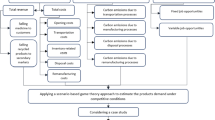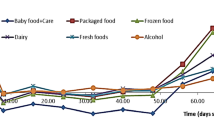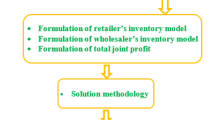Abstract
In a competitive environment, supply chains are competing with each other to gain the market share and competition is a critical factor influencing the supply chain network structure. The current paper presents a variational inequality formulation and provides the results for a competitive supply chain network design model. The new-entrant supply chain competes against an existing one in a non-cooperative behavior. The networks include raw material suppliers, manufacturers, retailers, and the same demand markets. The manufacturers produce multiple products with deterministic, price-dependent demand. The goal is to maximize the future revenue of both chains. The problem is modeled by mathematical programming and the governing Nash equilibrium conditions are derived. Then, a finite-dimensional variational inequality formulation is presented to solve the equilibrium problem. Qualitative properties of the equilibrium pattern are provided to establish existence and uniqueness results under reasonable conditions. The modified projection algorithm is used to solve the variational inequality problem. A numerical example is presented in order to show the efficiency of the proposed model and to investigate the behavior of the model under different conditions.









Similar content being viewed by others
References
Aboolian, R., Berman, O., & Krass, D. (2007). Competitive facility location model with concave demand. European Journal of Operational Research, 181, 598–619.
Ailawadi, K. (2001). The retail power-performance conundrum: What have we learned? Journal of Retailing, 77, 299–318.
Ashtiani, M. G., Makui, A., & Ramezanian, R. (2013). A robust model for a leader-follower competitive facility location problem in a discrete space. Applied Mathematical Modelling, 37, 62–71.
Baghalian, A., Rezapour, S., & Farahani, R. Z. (2013). Robust supply chain network design with service level against disruptions and demand uncertainties: A real-life case. European Journal of Operational Research, 227, 199–215.
Bass, F. M., Krishnamoorthy, A., Prasad, A., & Sethi, S. P. (2005). Generic and brand advertising strategies in a dynamic duopoly. Marketing Science, 24, 556–68.
Bawa, K., & Shoemaker, R. (1987). The coupon–prone consumer: Some findings based on purchase behavior across product classes. Journal of Marketing, 51, 99–110.
Beresnev, V. (2013). Branch-and-bound algorithm for a competitive facility location problem. Computers & Operations Research, 40, 2062–70.
Boyaci, T., & Gallego, G. (2004). Supply chain coordination in a market with customer service competition. Production and Operations Managements, 13, 3–22.
Christopher, M. (1998). Logistics and supply chain management—Strategies for reducing cost and improving service. London: Taylor & Francis.
Deloitte Consulting. (1999). Energizing the supply chain: Trends and issues in supply chain management, Report, Deloitte Consulting LLC, New York.
Fallah, H., Eskandari, H., & Pishvaee, M. S. (2015). Competitive closed-loop supply chain network design under uncertainty. Journal of Manufacturing System, 37, 649–61.
Farahani, R. Z., Rezapour, S., Drezner, T., & Fallah, S. (2014). Competitive supply chain network design: An overview of classifications, models, solution techniques and applications. Omega, 45, 92–118.
Feng, Z., Wang, Z., & Chen, Y. (2014). The equilibrium of closed-loop supply chain supernetwork with time-dependent parameters. Transportation Research E, 64, 1–11.
Fernández, J., Salhi, S., & Boglárka, G.-T. (2014). Location equilibria for a continuous competitive facility location problem under delivered pricing. Computers & Operations Research, 41, 185–95.
He, X., Krishnamoorthy, A., Prasad, A., & Sethi, S. P. (2011). Retail competition and cooperative advertising. Operetions Research Letters, 39, 11–6.
He, Z., Wang, S., & Cheng, T. C. E. (2013). Competition and evolution in multi-product supply chains: An agent-based retailer model. International Journal of Production Economics, 146, 325–36.
Hugos, M. (2003). Essentials of Supply Chain Management. New Jersey: John Wiley & Sons Inc.
Kinderlehrer, D., & Stampacchia, G. (1980). An introduction to variational inequalities and their application. New York: Academic Press.
Korpelevich, G. M. (1977). The extragradient method for finding saddle points and other problems. Matekon, 13, 35–49.
Kumar, R. S., Choudhary, A., Babu, S. A. K. I., Kumar, S. K., Goswami, A., & Tiwari, M. K. (2017). Designing multi-period supply chain network considering risk and emission: A multi-objective approach. Annals of Operations Research, 250, 427–61.
Kurata, H., Dong-Qing, Y., & Liu, J. J. (2007). Pricing policies under direct versus indirect channel competition and national versus store brand competition. European Journal of Operational Research, 180, 262–81.
Liu, Z., & Nagurney, A. (2013). Supply chain networks with global outsourcing and quick-response production under demand and cost uncertainty. Annals of Operations Research, 208, 251–89.
Nagar, K. (2009). Evaluating the effect of consumer sales promotions on brand loyal and brand switching segments. Journal of Bussines Perspective, 13, 35–48.
Nagurney, A. (1999). Network economics: A variational inequality approach (2 and Revised ed.). Dordrecht: Kluwer Academic Publishers.
Nagurney, A. (2010). Supply chain network design under profit maximization and oligopolistic competition. Transportation Research E, 46, 281–94.
Nagurney, A., Daniele, P., & Shukla, S. (2017). A supply chain network game theory model of cybersecurity investments with nonlinear budget constraints. Annals of Operations Research, 248, 405–27.
Nagurney, A., Dong, J., & Zhang, D. (2002). A supply chain network equilibrium model. Transportation Research E, 38, 281–303.
Nagurney, A., & Li, D. (2015). A supply chain network game theory model with product differentiation, outsourcing of production and distribution, and quality and price competition. Annals of Operations Research, 226, 479–503.
Petridis, K. (2013). Optimal design of multi-echelon supply chain networks under normally distrbuted demand. Annals of Operations Research, 227, 63–91.
Pishvaee, M. S., Jolai, F., & Razmi, J. (2009). A stochastic optimization model for integrated forward/reverse logistics network design. Journal of Manufacturing System, 28, 107–114.
Pishvaee, M. S., & Razmi, J. (2012). Environmental supply chain network design using multi-objective fuzzy mathematical programming. Applied Mathematical Modelling, 36, 3433–46.
Qiang, Q., Keb, K., Anderson, T., & Dong, J. (2013). The closed-loop supply chain network with competition, distribution channel investment, and uncertanity. Omega, 41, 186–194.
Redondo, J. L., Fernández, J., Hervas, J. D. A., Arrondo, A. G., & Ortigosa, P. M. (2014). Approximating the paretofront of a planar bi-objective competitive facility location and design problem. Computers & Operations Research, 62, 337–49.
Rezapour, S., & Farahani, R. Z. (2010). Strategic design of competing centralized supply chain networks for markets with deterministic demands. Advances in Engineering Software, 41, 810–22.
Rezapour, S., & Farahani, R. Z. (2014). Supply chain network design under oligopolistic price and service level competition with foresight. Computer & Industrial Engineering, 72, 129–42.
Rezapour, S., Farahani, R. Z., & Drezner, T. (2011a). Strategic design of competing supply chain networks for inelastic demand. Journal of the Operational Research Society, 62, 1784–95.
Rezapour, S., Farahani, R. Z., Dullaert, W., & Borger, B. D. (2014). Designing a new supply chain for competition against an existing supply chain. Transportation Research E, 67, 124–40.
Rezapour, S., Farahani, R. Z., Fahimnia, B., Govindan, K., & Mansouri, Y. (2015). Competitive closed-loop supply chain network design with price-dependent demands. Journal of Cleaner Production, 93, 251–72.
Rezapour, S., Farahani, R. Z., Ghodsipour, S. H., & Abdollahzadeh, S. (2011b). Strategic design of competing supply chain networks with foresight. Advances in Engineering Software, 42, 130–41.
Tabrizi, B., & Razmi, J. (2013). Introducing a mixed-integer non-linear fuzzy model for risk management in designing supply chain networks. Journal of Manufacturing System, 32, 295–307.
Tsay, A., & Agrawal, N. (2000). Channel dynamics under price and service competition. Manufturing and Service Operetions Management, 2, 372–91.
Wang, X., & Ouyang, Y. (2013). A continuum approximation approach to competitive facility location design under facility disruption risks. Transportation Research B, 50, 90–103.
Xiao, T., & Qi, X. (2008). Price competition, cost and demand disruptions and coordination of a supply chain with one manufacturer and two competing retailers. Omega, 36, 741–53.
Zhang, D. (2006). A network economic model for supply chain versus supply chain competing. Omega, 34, 283–95.
Author information
Authors and Affiliations
Corresponding author
Rights and permissions
About this article
Cite this article
Feyzian-Tary, I., Razmi, J. & Sangari, M.S. A variational inequality formulation for designing a multi-echelon, multi-product supply chain network in a competitive environment. Ann Oper Res 264, 89–121 (2018). https://doi.org/10.1007/s10479-017-2737-3
Published:
Issue Date:
DOI: https://doi.org/10.1007/s10479-017-2737-3




